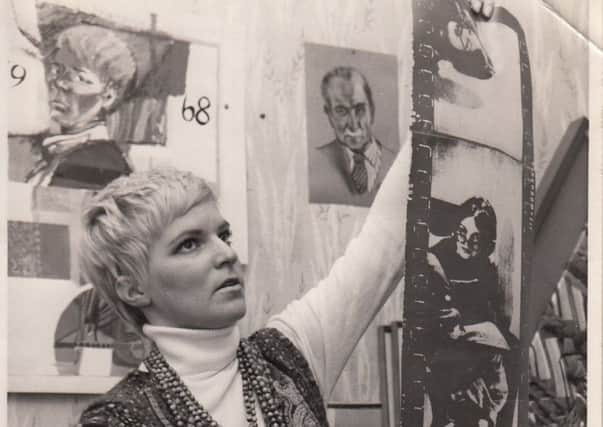Obituary: Maggie Riegler, Scottish artist internationally renowned for her tapestries


Maggie Riegler (nee Thom), the professional name under which she worked as an artist, was born in Darjeeling, India. Her parents were tea-planters from Aberdeenshire and her Ayah, or nanny, was Sherpa Tensing’s wife.
At the age of seven Maggie was sent back to Aberdeen to be looked after by a maiden aunt and attend primary school in Maryculter. This turned out to be a difficult period in her life, without her parents or brother and cared for by a woman who had fewer skills in cooking than she had in caring for a child, but Maggie’s indomitable spirit saw her through it.
Advertisement
Hide AdAdvertisement
Hide AdSome years later, while in secondary school, Maggie’s parents came home to retirement in Aberdeen. Despite those difficult intervening years, Maggie did so well at school that she was offered a place at Cambridge University to read English and History. However, much to the chagrin of her parents and teachers, she turned that opportunity down to study art at Gray’s School of Art in Aberdeen.
During her time as a student, Maggie married and later divorced her first husband, Wolfgang Riegler – hence her professional name. They had a daughter, Ruth, whom her second husband, Stewart, adopted when she was four.
Such was Maggie’s talent that after a post-diploma and a travelling scholarship to Finland, where she was taken under the wing of Finland’s most celebrated design house, Marimekko, she was offered, and accepted, the post of lecturer in charge of the Weaving Department at Gray’s. It was in this area of art – weaving, tapestry, macramé – that Maggie specialised, combining her artistic vision with her practical and dextrous ability which every craftsperson needs.
Prior to taking up her post, the college mounted an exhibition of Maggie’s paintings, which Stewart Johnston, then a student of pottery, discovered and fell in love with. He described seeing the collection as his most exciting experience of contemporary art. They met and married and were together for 50 years.
While Maggie continued to lecture at Gray’s, she and Stewart bought Dess Station on the Deeside line in 1969, which had just become available following Beeching’s cuts. There, Stewart established Dess Station Pottery.
A few years later Lucy was born and when she was four years old, Maggie resigned from the Gray’s and established her own tapestry studio alongside Stewart’s pottery. It was a risky step but the only way that Maggie could find the space and energy to fulfil her creative talent. Such was the artistic reputation she had already established that commissions soon appeared for large-scale works.
Later at Dess they established a publishing company, producing a wide range of correspondence and decorative cards and prints, with Maggie the creative department and Stewart marketing and printing.
In 1991 the couple moved from Deeside to Speyside, establishing the Green Hall Gallery in Craigellachie. There, Maggie did many paintings to meet local demand and widened her repertoire, producing at least 11 designs for limited editions of Speyside whiskys for the Craigellachie Hotel and later The Highlander Inn.
Advertisement
Hide AdAdvertisement
Hide AdThey also collaborated on a painting commemorating the amalgamation of The Seaforth and the Gordon Highlanders, with Stewart doing the drawing and Maggie the painting.
Maggie’s work has been exhibited across the world, from Europe to the United States and Australasia, and her pieces are held in such public collections as the Aberdeen Art Gallery, The British Embassy in Cairo, The Liverpool Education Authority, The Royal Scottish Museum and The Scottish Arts Council.
Her large commissioned pieces include tapestries for The Bank of Scotland, the Mobile UK and Chevron UK oil companies and St Mary’s Cathedral in Aberdeen, and Eden Court Theatre in Inverness. She also completed commissions for Avon Cosmetics, Boots, Diagio, The Scottish Society for the Prevention of Cruelty to Animals, Web Ivory and the World Wildlife Fund, among many others.
Perhaps her largest tapestry was a commission from P&O in 1984 for their new liner, the Royal Princess, which was named and launched by the late Diana, Princess of Wales at Southampton Docks. After the event, by a slip of protocol, Maggie and Stewart found themselves aboard the Royal Train so they travelled back to London in style.
Maggie was generous, astute, forthright and modest: an indomitable and mercurial spirit. She never put her art above her family and shared her love and knowledge of literature, poetry and the arts with all. She leaves behind a very diverse oeuvre across many private collections and galleries.
Maggie died in the Fleming Cottage Hospital in Aberlour, where she was wonderfully cared for, following a debilitating illness.
She is survived by her husband Stewart and her daughters Ruth and Lucy.
CONTRIBUTED